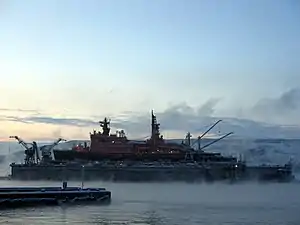Rossiya (icebreaker)
Rossiya (Russian: Россия; literally: Russia) is a Russian Arktika-class nuclear-powered icebreaker. In 1990, it became the first ship to carry commercial passenger traffic to the geographic North Pole.[4] Its sister ship Arktika was the first surface ship to reach the pole.
 Rossiya on a dry dock | |
| History | |
|---|---|
| Name: | Rossiya (Россия) |
| Owner: | Russian Federation |
| Operator: | FSUE Atomflot |
| Port of registry: |
|
| Builder: | Baltic Shipyard |
| Yard number: | 702 |
| Laid down: | 20 February 1981[1] |
| Launched: | 2 November 1983 |
| Commissioned: | 20 December 1985 |
| Decommissioned: | 2013 |
| In service: | 1985–2013[2] |
| Identification: |
|
| Status: | Laid up |
| General characteristics [3] | |
| Class and type: | Arktika-class icebreaker |
| Tonnage: | |
| Displacement: | 23,000 tons |
| Length: | 148 m (486 ft) |
| Beam: | 30 m (98 ft) |
| Draught: | 11 m (36 ft) |
| Depth: | 17.2 m (56 ft) |
| Ice class: | RMRS Icebreaker9 |
| Installed power: | Two OK-900A nuclear reactors (2 × 171 MW)Two steam turbogenerators (2 × 27.6 MW) |
| Propulsion: | Nuclear-turbo-electricThree shafts (3 × 18 MW) |
| Speed: | 20.6 knots (38.2 km/h; 23.7 mph) (maximum) |
| Endurance: | 7.5 months |
| Crew: | 189 |
| Aircraft carried: | 1 × Mi-2, Mi-8 or Ka-27 helicopter |
| Aviation facilities: | Helipad and hangar for one helicopter |
During the winter of 2012–2013, Rossiya was stationed in the Gulf of Finland.[5]
According to Bellona, Rossiya was taken out of service in 2013 and is currently in "cold lay-up" awaiting disposal.[6]
References
- Yard plate
- Russian nuclear icebreaker Rossiya taking last voyage along Norway’s coast. Bellona, 11 April 2013. Retrieved 2016-11-16.
- "Atomic Icebreakers Technical Data". rosatomflot.ru. Retrieved 9 October 2017.
- Venäjä lähettää jättikokoisen atomimurtajan Suomenlahdelle. Tekniikka & Talous, 29 November 2012. Retrieved 2012-11-29.
- Russia prepares to dismantle first nuclear icebreaker ever. Bellona, 14 November 2016. Retrieved 2016-11-16.
This article is issued from Wikipedia. The text is licensed under Creative Commons - Attribution - Sharealike. Additional terms may apply for the media files.